Arts
Bonding with Bonsai
“It is like a child to me,” Ashan Gunathilake says fondly, pointing at the small Malpighia which has grown to maturity, its tiny roots embracing the rock. “We talk in a language which is understood only by me and the tree. It is a spiritual bond.”
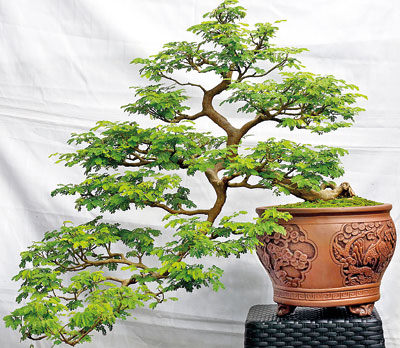
Premasiri’s Brazilian rain tree in semi cascading style
Ashan is a young Bonsai artist who is passionate about the art of miniature trees. A graduate in Agriculture, Ashan was always looking for means to connect horticulture and science with art. He found the amalgamation he was looking for in a picture of a bonsai tree. Falling in love with the art virtually at first sight, Ashan started learning Bonsai eight years ago. With skill and an eye for creativity he has made significant progress – he was adjudged first runner-up in both the Small Bonsai category and Best Bonsai group in the beginners’ category at the annual Bonsai exhibition held by the Sri Lanka Bonsai Association (SLBA) in May.
“I get completely detached for hours from the outside world when I groom a tree. It is a moment of perfect peace,” Ashan explains. A Bonsai plant should be looked after with extreme care as any neglect could cause the tree to grow out of proportion, or even die. Having his own Bonsai plant nursery, “Thadee Bonsai” in Agalawatta, Ashan is able to give specific instructions to his customers on how to maintain a Bonsai plant.
The art of Bonsai – creating a miniature tree which replicates a natural full size grown tree, originated in China, and centuries later, the Japanese adopted Bonsai as a traditional form of art developing it with specific forms, styles and interpretations and popularising it worldwide thereafter. The Japanese word ‘Bon-sai’ means “planted in a container.”
The Sri Lanka Bonsai Association founded in 1989 encourages beginners to learn Bonsai and promotes Bonsai culture in Sri Lanka. A senior Bonsai artist and the president of SLBA, Naveen Sooriyarachchi defines Bonsai as an effortless way of meditation, “I could sit for hours just looking at a Bonsai tree,” he says.
According to him this year’s annual Bonsai exhibition had been a revelation as lots of beginners and novices showcased exhibits of high standard.
But with the demand for Bonsai plants growing, Naveen cautions that fake Bonsai is also found in the market. “A Bonsai should not be confused with a dwarfed tree.
A real Bonsai should mimic a mature full-size tree,” Naveen says. He explains that a Bonsai should meet certain basic requirements such as the tree should be hardwood, should branch out and preferably be a single leaf tree.
“In some way Bonsai is an illusion and the artist is a magician. If a tree looks 50 years old in one year, the artist has nailed the job,” Naveen says, revealing a trick they perform to create the signs of aging- wiring the branches down.
The Bonsai collection on the balcony, just outside his bedroom is a ‘secret garden’ for M.A. Pemasiri to take a break from his profession as a civil engineer. Being a senior member of SLBA he is still passionate about Bonsai and has a collection around 50 plants including Orange Jessamine (Atteriya), Wrightia, Boxwood, Ceylon Iron Wood (Palu), Beechwood (Demata), Siris (Mara) and Powder-puff.
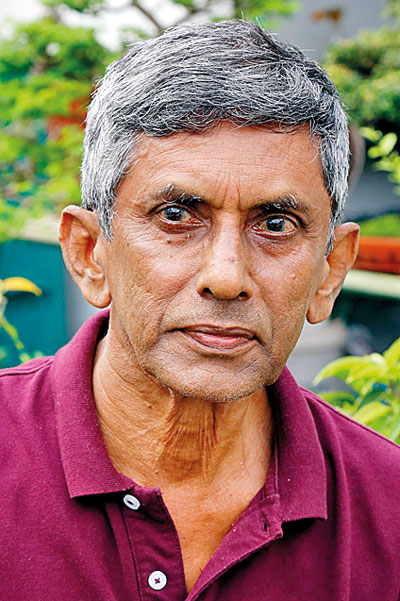
M.A.Premasiri
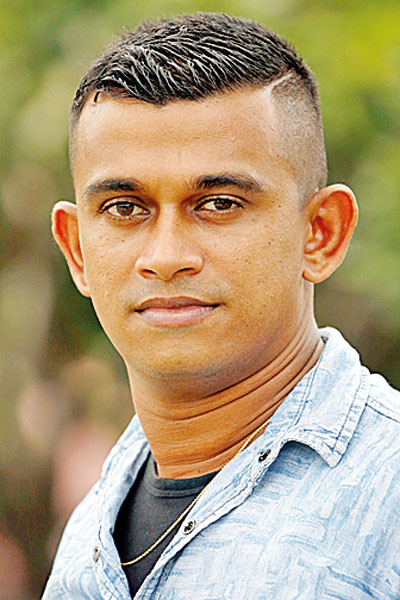
Ashan Goonathilake
As Pemasiri says Bonsai has been advanced into many styles and forms over the years yet some basic forms remain most used-‘Formal upright’ in which the growing trunk is clearly visible and thicker at the bottom, gradually getting thinner with the height, ‘Informal upright’ with the trunk roughly shaped as the letter‘s’, ‘Slanting Bonsai’ grown leaning to one side, “ Cascade’ portraying a tree on a steep cliff bending downward and ‘Semi-cascade’ where a tree on a river bank bends downwards or sidewards.
“In Bonsai the medium is a live specimen, the artist creates a visual impact according to his imagination and the tree should tell its own story, reflecting the signs of withering with time, being struck by lightning, swept by the wind or developing with a twisted trunk,” he says.
A Bonsai plant should be kept in good sunlight and watering the plant is essential. The growing medium is a mixture of charcoal, pieces of bricks, cowdung and river sand. The soil should not contain much water as the roots would be likely to decay.
A well proportioned Bonsai is indeed an exquisite creation which would make you seem like a giant in front of a full grown but miniature tree. The mere sight of it calms the mind.
Says Pemasiri, “you will grow a tree in the house which is gigantic by nature that you would never have imagined growing even in your backyard.”
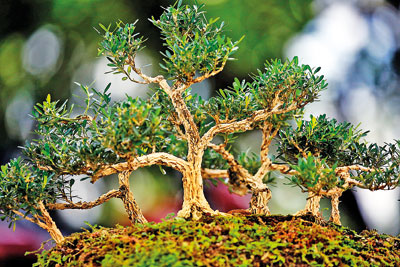
Ashan’s English boxwood and below, malphigia. Pix by M.A. Pushpa Kumara
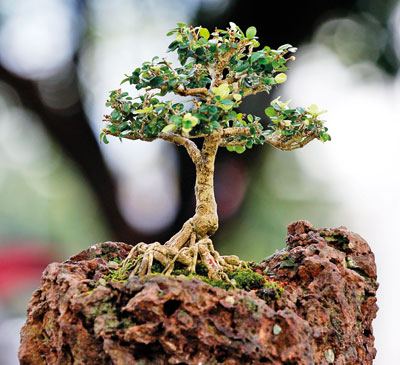
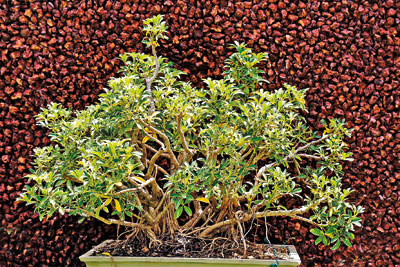
Naveen’s Schefflera Clump and right False Cypress
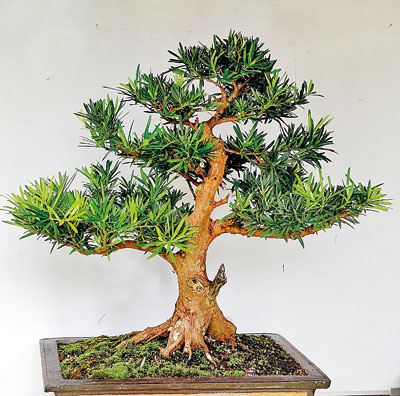
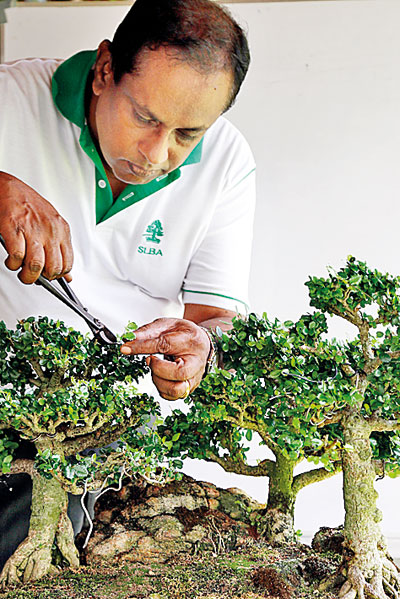
Naveen Sooriyarachchi: Attention to detail
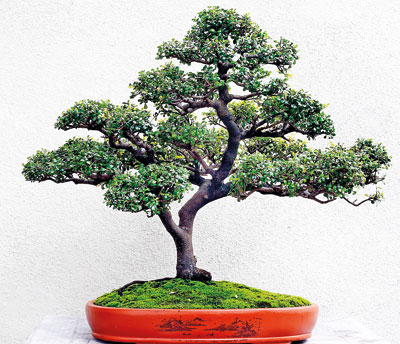
Premasiri’s Kalu Habaraliya and right Cherry tree bearing fruit
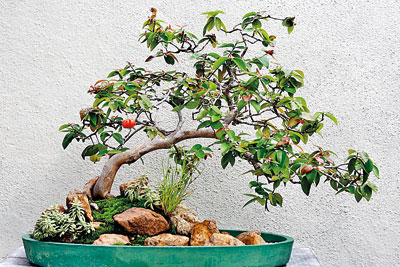
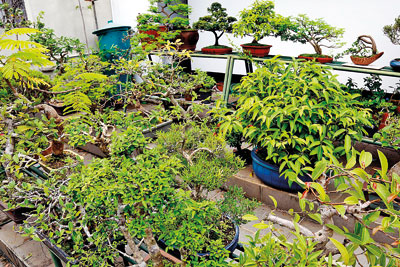
Premasiri’s Bonsai collection on the balcony

